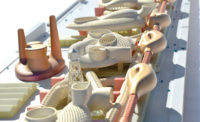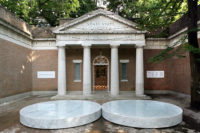Motown Meets Venice at 2018 Architecture Biennale

For his contribution to the U.S. pavilion exhibition, Stan Allen envisions Albert Kahn’s Packard Automotive Plant in 2045.
Photo © Stan Allen Architect

Preston Scott Cohen has designed an undulating canopy for the George W. Young Post Office.
Photo © Preston Scott Cohen, Inc.

Marshall Brown Projects contributed a speculative tower for Detroit’s Dequindre Cut greenway.
Photo © Marshall Brown Projects

The Architectural Imagination cocurator Monica Ponce de Leon designed a group of foam columns that will stand in front of the neoclassical U.S. pavilion.
Photo © Monica Ponce de Leon

LA-based firm Pita & Bloom proposes a vaulted marketplace with parking beneath for its project, the New Zocalo.
Photo © Pita & Bloom





When he was named director of the 15th Venice Architecture Biennale, Chilean architect Alejandro Aravena asked curators to focus on projects that “improve the quality of the built environment and life and consequently people’s quality of life.”
At the time, Cynthia Davidson and Monica Ponce de Leon, curators of the U.S. pavilion at the Biennale, were already working on a program that answered Aravena’s call. When the pavilion opens on May 28, it will contain speculative designs by 12 architecture firms for four sites in Detroit. Two are empty lots, one adjacent to the burgeoning community known as Mexicantown and one near the thriving Eastern Market. Two are existing buildings—an abandoned, derelict Packard factory by Albert Kahn and a semi-occupied post office near the riverfront. Davidson and Ponce de Leon chose the four sites in consultation with local leaders and selected the 12 architects out of 253 entries in an open competition. Some of the offices are well established—Greg Lynn FORM of Los Angeles and Mack Scogin Merrill Elam Architect of Atlanta—while others are relative unknowns. Two are in Michigan: A(n)Office in Detroit and T+E+A+M in Ann Arbor.
Together, Davidson says, the firms offer “a diversity in age and ethnicity that is very representative of the U.S. today.”
The architects were asked to come up with programs as well as designs. They met with a diverse group of locals, including businesspeople; a bishop and church congregants; and architects and planners, including Maurice Cox, the new director of city planning, who is on the pavilion board of advisors. The programs the architects came up with include a mix of parks, marketplaces, schools, housing, sports facilities, a library, greenhouses, and even an aviary.
For the exhibition, titled The Architectural Imagination, each firm has created a 4-by-7-foot model that will stand in one of the four rooms of the neoclassical U.S. pavilion in the Giardini in Venice. The walls will be crowded with study models and drawings, some 250 items in all. “It’s going to have a Soane-esque quality,” says Davidson, referring to the plethora of drawings, paintings, and models in Sir John Soane’s Museum in London. But Soane depicted an idealized past. This exhibition will focus on a somewhat humbling present. “But we’re not exhibiting Detroit,” says Davidson, head of an architecture think tank that produces books, conferences, and the journal Log. “We’re exhibiting new possibilities for Detroit.” The takeaway is meant to be ideas that can be applied in cities around the world.
There will also be a physical takeaway: the curators invited photographers to submit images of present-day Detroit. Out of nearly 500 entries, they chose 20 that will be printed as postcards, available free at the pavilion. If there is a theme to the photos, it is of people adapting to decline. One shows a wedding party in front of the city’s decrepit former train station; another shows a teenage boy casually riding his bicycle past what appears to be a burning building.
The exhibition design by Ponce de Leon, former dean of architecture at the University of Michigan and now dean at Princeton, calls for a group of columns that will stand in front of the pavilion, forming what she terms “a hypostyle without a roof.” Made of foam and covered in white automotive paint, the columns will beckon visitors with the words The Architectural Imagination written in Detroit’s eight most-spoken languages, including Arabic and Hebrew.
From Venice, the exhibition will move to the Museum of Contemporary Art Detroit (MOCAD) next year.







